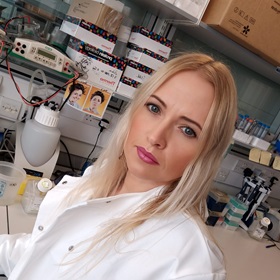Image of human melanoma tissue, with melanoma cells in green and purple extracellular matrix fibres arranged perpendicular at the border of the tumour. Credit Oscar Maiques Carlos
Scientists have discovered a new way to predict which tumours will become aggressive before they metastasise and spread around the body.
New research, published in Nature Communications, reveals how cancer cells are altered by their surroundings, enabling them to change their shape and break out of a tumour. The discovery paves the way for treatments that will tackle cancer before it can spread.
Scaffolding around tumours acts as a 'roadmap'
Tumours are held together by a structure called the extracellular matrix (ECM), which acts like the scaffolding around a building under construction.
A team from The Institute of Cancer Research, London, and Barts Cancer Institute at Queen Mary University of London (BCI-QMUL), discovered how cancer cells use the layout of this scaffolding structure as a ‘roadmap’ to leave the tumour. They found that the ECM triggers changes within the cancer cells themselves – altering their shape and boosting their ability to travel to different parts of the body.
This breakthrough, which is the culmination of almost a decade of research that began at King’s College London, means that aggressive tumours that are likely to metastasise can now more easily be identified at an earlier stage – allowing clinicians to tailor treatment sooner. Drugs are currently in development to target the ECM’s layout, as well as the genes that drive these cell shape changes – which could stop cancer in its tracks before it can escape the tumour and spread.
Extracellular matrix provides the 'tracks' for cells to follow
The team, funded by Cancer Research UK and Barts Charity, and working in the Breast Cancer Now Toby Robins Research Centre at The Institute of Cancer Research (ICR), looked at tumour tissue from 99 patients with melanoma skin cancer and breast cancer.
They saw that the ECM was laid out differently in three distinct areas of the tumour. Like scaffolding, the ECM is made up of a number of components, including pole-like fibres. At the centre of the tumour, the fibres were spread out and disorganised, whilst at the border they were tightly packed and thicker. At the outermost border of the tumour, the fibres were arranged pointing away from the tumour – providing the ‘tracks’ for the cancer cells to follow as they escape from the tumour. At this outermost border of the tumour, the cancer cells were rounded – a more invasive cell shape.
Aggressive cells have a different expression of genes
The team tested whether the conditions at the border of the tumour make the cancer cells more aggressive. They grew melanoma cancer cells in a model of these conditions and injected them into mice. Cancer cells grown in these conditions were more likely to spread to the lungs and metastasise than melanoma cells grown in control conditions with disorganised fibres.
The researchers saw differences in the type of genes present in the cells depending on where in the tumour they came from. Cells at the border of the tumour had more genes linked to cell migration, rounding of the cell shape, and inflammation – all making the cells more aggressive and likely to survive. The team also saw an increase in the expression of genes for enzymes that impact the organisation of the matrix – highlighting how cancer cells corrupt their surroundings to break out of the tumour.
Comparing these findings to cancers from patients with 14 different tumour types, including melanoma, breast, pancreatic, lung cancer and glioblastoma – an aggressive brain cancer – the researchers found that a higher presence of these genes was associated with a shorter survival time.
Treating cancer before it spreads
The researchers say that these findings open new avenues for treatment to tackle cancer before it can spread, such as drugs targeting lysyl oxidase (LOX), which are already in clinical trials for other conditions. These drugs work by targeting an enzyme that stabilises the matrix, which is found more abundantly in the border region of tumours. The ICR has previously carried out research to show the possibility of targeting LOX in cancer treatment.
Professor Victoria Sanz Moreno, Professor of Cancer Cell and Metastasis Biology at The Institute of Cancer Research, London, who led the study said:
“Our research has uncovered the roadmap that cancer cells follow to break out of a tumour, enabling it to cause a secondary tumour elsewhere in the body. Now that we understand this roadmap, we can look to target different aspects of it, to stop aggressive cancers from spreading.
“The fibres in the structure surrounding the tumour are denser and are laid out like a path for cells to follow, the further out at the border of the tumour that we look. Future research should explore ways to target this arrangement, to prevent cancer cells from being able to escape and follow this path. We may also find that targeting this dense arrangement of fibres means other drugs can reach cancer cells more easily, which could improve how well treatments work.”
'What's on the outside of the tumour is just as important as what's in the centre'
Dr Oscar Maiques, Group Leader and Lecturer in Digital Pathology at the Barts Cancer Institute at Queen Mary University of London, said:
“This study is the culmination of almost a decade of research to understand how cancer cells interact with their surroundings, known as the extracellular matrix.
“Importantly, we see that various regions of the tumour hold different information about that cancer’s future behaviour. When clinicians biopsy the tumour, our research shows that what’s on the outside of the tumour is just as important as what’s in the centre – as this holds crucial information about whether a cancer is likely to spread.”
Cancer operates in a 'complex ecosystem'
Professor Kristian Helin, Chief Executive at The Institute of Cancer Research, London, said:
“We know that most cancer deaths occur because cancer has spread from the original tumour to other parts of the body, at which point it becomes much harder to treat. To develop better treatments for cancer patients, we must understand the complex ecosystem in which it operates. This research reveals how a tumour’s surroundings alter the cancer cells within it and enable them to spread. I hope that further research will lead to the development of treatments that target these interactions and prevent cancer from spreading.”
Dr Iain Foulkes, Executive Director of Research and Innovation at Cancer Research UK, said:
“Understanding how cancer spreads is crucial to finding treatments which can stop the disease advancing further. This research shows how much cancer relies on the scaffolding around it to move and spread elsewhere. Cutting down this scaffolding could deprive cancer of opportunities to spread and improve the chances of successful treatment, and I look forward to further research which hopes to achieve this aim.”

 .
.